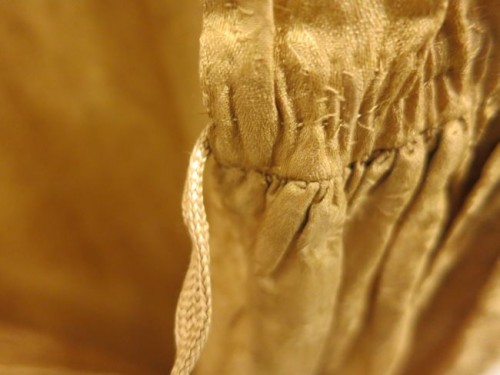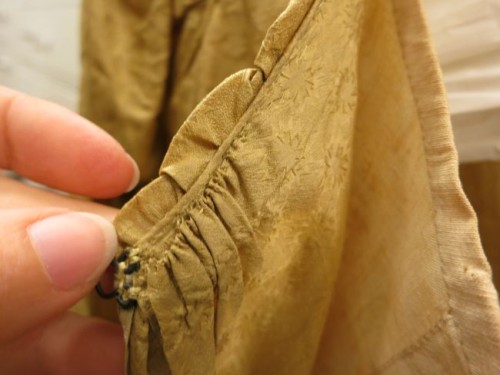Over the last year I’ve been gradually showing you images that I took when I was last in Hawaii of some of the beautiful historical garments at the Honolulu Museum of Art. You’ve seen the amazing embroidered cisele velvet 18th century man’s suit, a late 19th century Turkish tea robe that had been altered for wear by a Western woman, and a teaser-taster of all the textiles.
Today I’m showing you what was possibly my favourite of all the things I photographed:

Dress, circa 1810 (with alterations), Honolulu Museum of Art
Can you guess why? Yep -it’s totally swoon-worthy, angels sing, yellow gold silk!
And the fabric itself is just amazing:

Dress, circa 1810 (with alterations), detail of fabric, Honolulu Museum of Art

Dress, circa 1810 (with alterations), detail of fabric, Honolulu Museum of Art
I’m not even sure how to describe the fabric – it’s a quite soft, lightweight silk, in a sort of brocade weave, but with the floating wefts reversed to the front of the fabric. Very unusual, and not something I think I’ve ever seen before. The small overall pattern, however, is quite common in early 19th century gowns.
Those of you who have looked closely at the photo above will have noticed something odd. That isn’t hand-stitching on the bodice front!

Dress, circa 1810 (with alterations), Honolulu Museum of Art
No, it’s not. There are some weird, slightly inexplicable, alterations to the bodice front. I think originally it may have looked a bit more like this 1810s gown from Abiti Antichi, with a shaped bodice front, but at some point after the introduction of sewing machines the front was altered to be completely flat, with no room for a bust curve. The rest of the dress still has the original hand stitching.

Dress, circa 1810 (with alterations), Honolulu Museum of Art

Dress, circa 1810 (with alterations), Honolulu Museum of Art
The alterations make me wonder about the ruched trim around the neck. How much of it is original, and what did the neckline look like before the alterations? Unfortunately, in the short amount of time I had at the HMA I wasn’t able to inspect the dress in enough detail to determine how much of the trim was altered, though its definitely hand-sewn around the back edge.

Dress, 1st quarter of the 19th century (with alterations), Honolulu Museum of Art
The bodice back, and the rest of the dress construction, is entirely hand-sewn, and quite typical of the early 19th century, with armscythes that are set well back, seams defined by narrow piping, fullness only at the centre back, and back ties to fasten.

Dress, 1st quarter of the 19th century (with alterations), Honolulu Museum of Art
The bodice of the dress is lined with linen, with a seperate piece of linen at the bodice back that fastens independently underneath the outer silk (the image two up, and the final image in this post, both show this detail).

Dress, 1st quarter of the 19th century (with alterations), Honolulu Museum of Art
The handstitching on the dress is beautifully done, and very even throughout, but not tiny: there are 10-12 stitches per inch.

Dress, circa 1810 (with alterations), Honolulu Museum of Art
The original construction details are also beautifully done: fine, even back gathers whipstitched into the centre back:

Dress, circa 1810 (with alterations), Honolulu Museum of Art
A discreet drawstring runs through the high waist, to snug it in under the bust (unfortunately I didn’t note if the drawstring was an original silk piece, or a later replacement):

Dress, circa 1810 (with alterations), Honolulu Museum of Art
The drawstring fastens the dress at the back waist, and the linen under bodice also fastens with a tie at the back, with the outer bodice hooking over it. The thread that is holding the hook on is not the same as the rest of the thread, so I wasn’t able to determine if it was a later addition, or if it has simply been re-sewn on after coming loose (as often seems to happen with hooks).

Dress, circa 1810 (with alterations), Honolulu Museum of Art
The images I’ve shown you are every single one I took of this dress. I wish I’d taken more! Even with the alterations, it’s such a fantastic garment, with such beautiful details of construction techniques circa 1810. I’m so grateful for the HMA for allowing me to explore their collections, and for being such gracious hosts. Next time I go home I’m going to try to schedule a couple of days in Honolulu so that I can examine it, and some of the other treasures in the HMA, in more detail.
Maybe Mr D wants to spend Christmas in Hawaii this year so I can go to the Sheer Delight exhibition…

My goodness, I’m very much loving the silk with its mini, oh-so-restrained sunbursts… Thanks for your detailed descriptions of the construction, wonderful to read and see.
Isn’t the fabric GORGEOUS? I am so in love with it, but I’ve really never seen a fabric that even approaches the weave, pattern and hand, so I can only dream of replicating it. And you’re most welcome!
It is beautiful fabric; I can’t imagine what it must feel like to touch.
Thank you so much for sharing! It’s great to see construction details. And the fabric is sooo lovely…
That fabric is amazing.
Thanks for showing those construction close ups, I really appreciate them. My biggest problem with museums’ online collections is that they don’t post construction detail photos. Sigh… I guess their target audience is less nerdy than me.